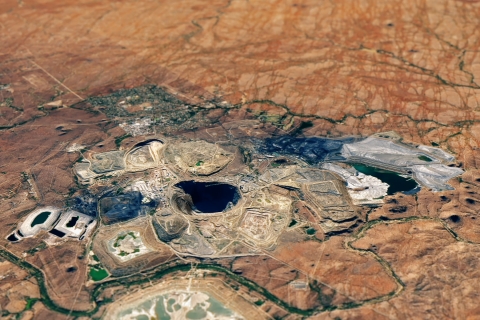
As nations in the Global North rush to transition to carbon-neutral energy, extractive industries exploit countries such as the Democratic Republic of Congo to meet the growing mineral demand.
The following article was published in the May-June 2024 issue of NewsNotes.
At the conclusion of the hottest year in recorded history, the world’s nations gathered in Dubai at the UN COP 28 conclusively named and shamed the culprit of the madness: fossil fuels.
On the heels of this belated but vital decision to transition from fossil fuels came a global commitment to triple renewable energy. And fast. According to leading climate scientists, this needs to happen within six to seven years to avoid unleashing cataclysmic climate events.
To many in the Global North, where the burning of fossil fuels built their nation’s wealth – the fix is simply a technical one, mostly involving switches, such as from a gasoline powered vehicle to an electric one. Multiplied by millions, these choices will prevent gigatons of emissions from further heating the planet. All the while new businesses and jobs are created. It certainly sounds like a win-win proposal.
That is, until we look a bit deeper and ask: where will we get the minerals needed for the massive outlay of renewable energy that will allow us to keep our lawns and lifestyles?
The answer is troublesome. The majority of these minerals will come from lands whose stewards have contributed almost nothing to climate change yet already are feeling its effects more intensely.
Such is the case of the Democratic Republic of the Congo. According to the Intergovernmental Panel on Climate Change (IPCC) the DRC is one of the countries most vulnerable to the effects of climate change due to the warming of its lakes and the reliance of the population on subsistence fishing. Meanwhile, the DRC is lowest per-capita greenhouse gas emitter in the world, putting out just 0.03 tons of CO2 in 2022.
Yet it is in this African nation where the key mineral in the manufacture of lithium ion rechargeable batteries is found: cobalt. The DRC is home to more cobalt reserves than the rest of our planet combined. Rather than a win-win formula the mining of cobalt seems more of a lose-lose. Hundreds of villages have been bulldozed to make room for mines, millions of trees cut down, hundreds of thousands left to breath toxic air while tens of thousands mine the cobalt in conditions compared to 21st century slavery.
On the other side of the planet lie vast reserves of another mineral essential to batteries — lithium. It is estimate that over the next two decades the “Lithium Triangle” of Chile, Argentina, and Bolivia, home to more than 75 percent of the world’s supply, will see a 90 percent increase in demand. This area is one of Earth’s driest places. Miners must drill holes in the salt flats, pump mineral-rich brine to the surface then evaporate the water some 18 months before extracting the lithium. This process requires massive amounts of water — about 500,000 gallons of water per ton of lithium, causing extreme water shortages to already arid areas.
Not surprisingly, mining companies have descended upon these salt flats scoring massively one-sided deals. The joint Canadian-Chilean venture Minera Exar struck an agreement with six Indigenous communities that would bring some $250 million a year to the company while paying out a paltry $9,000 to $60,000 to each community.
At a recent hearing on Green Extractivism at the European Parliament, Valentina Vidal, a young Argentine living near a lithium mine, spoke out: “What you think of as clean energy we think of as violence, criminalization, death. We are not willing to maintain your levels of consumption. You want to keep up with your lifestyle at the cost of our lives, our communities.”
Too often, the cost of mining is that of a life. Communities that have stewarded some of the most extraordinary biodiversity on our planet for millennia find themselves defending their land and villages from the devastations of mining. In April, the Pan-Amazonian Ecclessial Network (REPAM) reported that another land defender had been murdered. They have documented over 147 cases. Meanwhile, the Amazon approaches the tipping point of turning from a rain forest to a dry savannah.
The global decision to transition away from fossil fuels is a necessary one. But a single-minded focus that ignores the underlying value of an integral ecology risks creating new tragic ecological crises as fast as it solves the last.
Pope Francis affirms that more than new expressions of extractivism are needed to save our planet:
“I consider it essential to insist that to seek only a technical remedy to each environmental problem which comes up is to separate what is in reality interconnected and to mask the true and deepest problems of the global system. To suppose that all problems in the future will be able to be solved by new technical interventions is a form of homicidal pragmatism, like pushing a snowball down a hill” (Laudate Deum 57).
NASA Earth Observatory image by Joshua Stevens and Allison Nussbaum, using Landsat data from the U.S. Geological Survey and topographic data from the Shuttle Radar Topography Mission (SRTM).
